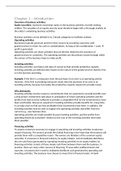Samenvatting
Samenvatting Equity Valuation and Analysis, ISBN: 9781079983357 Financial Statement Analysis & Valuation (323059-M-6)
- Instelling
- Tilburg University (UVT)
Samenvatting over de hoofdstukken uit het voorgeschreven boek voor het vak Financial Statement Analysis and Valuation. Zelf heb ik veel gehad aan het leren van deze samenvatting omdat het de belangrijkste punten uit het boek en de lessen omvat.
[Meer zien]





